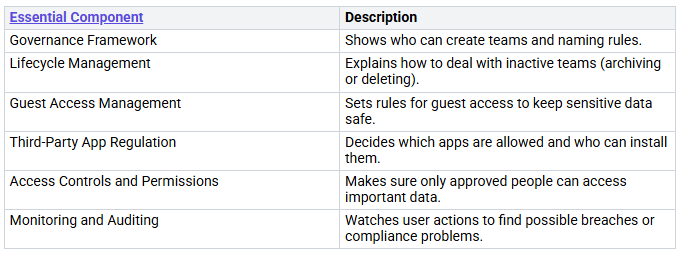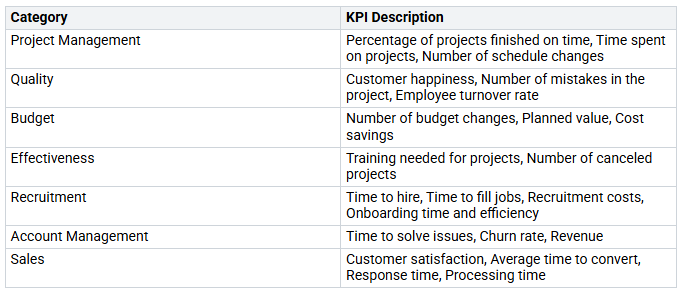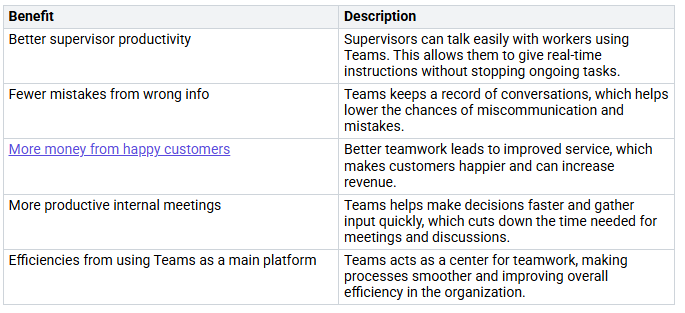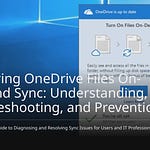In today’s work environment, good Microsoft Teams governance is very important for productivity. By setting clear rules, you can improve teamwork without adding problems. Recent studies show that companies have seen a 50% rise in teamwork over the last five years. Tools like co-authoring and version control help workers save four hours each week. This results in big savings, with $14.3 million earned over three years. Better communication through Microsoft Teams governance not only makes work easier but also helps your team work better.
Key Takeaways
Set clear rules to improve teamwork and productivity in Microsoft Teams.
Define roles and tasks to create responsibility and lessen confusion among team members.
Use role-based access control to keep data safe and limit permissions based on user roles.
Regularly check and review team activities to find compliance problems and possible security risks.
Apply data management rules to sort and handle sensitive information well.
Promote user training and help to boost Microsoft Teams use and understanding of governance.
Collect feedback from team members to keep improving governance rules and meet user needs.
Match governance plans with business goals to create a friendly and productive work environment.
Microsoft Teams Governance Overview
Good Microsoft Teams governance is very important for any group that wants to boost productivity and teamwork. Governance means the set of rules and steps that guide how teams work in Microsoft Teams. It creates clear rules for making, managing, and securing teams. This system helps you keep control while letting your teams succeed.
Importance of Governance
Role in Collaboration
Governance is key for helping teamwork. It shows how teams should talk and share information. By setting roles and duties, you create responsibility. This helps avoid confusion and makes sure everyone knows what to do.
Think about these important parts of governance:
Governance Policies: Set rules for teamwork and managing resources.
Roles and Responsibilities: Explain who is responsible for different tasks in Microsoft Teams.
Compliance and Security: Make sure all teamwork follows necessary rules and security measures.
Groups that use strong governance plans often see better teamwork. For instance, companies like Cummins and Amtrak have noticed better collaboration and smoother communication through good governance methods.
Impact on Efficiency
The effect of governance on efficiency is very important. Without good governance, groups face many problems:
Losing control over team creation can cause Teams sprawl.
Data leaks can happen from outside users without checks.
Too much information and compliance problems come from weak data rules.
By making clear policies, you can reduce these risks. A strong governance plan helps you manage resources well, which leads to better efficiency.
Key Components
Policies and Procedures
A good governance plan has several key parts. Here’s a summary:
Compliance Measures
Compliance measures are crucial for keeping your governance plan strong. Here are some common steps:
Define Clear Policies: Set rules for team creation, naming, and membership.
Use Templates: Use team templates to make team structures the same.
Monitor and Audit: Regularly check team activity and membership.
Train Users: Teach employees how to use Teams well.
Leverage Tools: Use governance tools to help enforce policies.
By following these steps, you can make sure your governance plan stays effective and useful.
Key Policies for Microsoft Teams Governance
Good Microsoft Teams governance needs clear policies. These rules help with user access and data management. They improve security and help teamwork and following rules in your organization.
User Access Policies
User access policies are very important. They keep things safe and make sure users have the right permissions. Here are two key parts:
Role-Based Access Control
Role-based access control (RBAC) lets you give permissions based on user roles. This helps keep things safe and makes work easier. Here are some benefits:
Using the least privilege rule can lower security problems. For example, TechCorp Solutions saw a 40% drop in security issues in six months after using RBAC.
Regular access checks, like those done by Fabrikam Inc., cut potential access issues by 70% by finding unnecessary permissions.
To stay safe, limit Global Admins. Microsoft suggests having fewer than five Global Admins to protect important accounts. Also, using Multi-Factor Authentication (MFA) can lower the chance of account hacks by 99.9%.
Guest Access Guidelines
Managing guest access is very important. It protects company data and helps follow rules. You should have strict controls for external users. Here are some guidelines:
Regular checks of guest access are key for safety and following rules. For example, groups with federal contracts or SOC 2 rules must add extra checks like multi-factor authentication.
Data Management Policies
Data management policies are key for following rules and handling data well in Microsoft Teams. Focus on two main areas: data classification and retention schedules.
Data Classification
Data classification helps you sort information by sensitivity. This ensures sensitive data gets the right protection. Here are some best practices:
Know your organization’s rules to sort data well.
Define what data belongs to each sensitivity level.
Check data stores to make sure everything is sorted correctly.
Use data management policies to control how long data is kept, deleted, or archived.
Set rules for file sharing, saying which files can be shared outside or inside. Teaching users about safe file sharing is also very important.
Retention Schedules
Retention schedules help manage data well and follow rules. Setting retention policies allows safe storage of edited or deleted messages. These messages can be found during eDiscovery searches by compliance admins. Here are some key points:
When retention policies say to delete messages, they can be automatically deleted. This keeps data management in line with rules.
Organizations can change retention policies for different message types. This allows better data management and compliance plans.
By using these data management policies, you can make sure your organization follows rules while managing data well.
Bridging Policies and Productivity
Good Microsoft Teams governance is very important for boosting productivity. You can connect governance rules with your business goals. This helps create a better and more cooperative workplace. Here’s how to make this change happen.
Aligning Governance with Business Goals
Identifying Productivity Metrics
To see how your governance rules affect productivity, find the right metrics. These metrics show how well your teams use Microsoft Teams. Think about tracking these:
By focusing on these metrics, you can make sure your governance rules help productivity and improve the employee experience.
Encouraging Innovation
You should also support new ideas in your teams. Set clear governance goals that match your business aims. Use main governance rules that improve security and how things run. This stops uncontrolled team creation and keeps data safe. Regularly checking access makes sure your governance stays strong.
Fostering a Collaborative Culture
Training and Support
Training and support are key for making governance work well. Giving practical knowledge improves Teams use and lowers risks. Governance skills help build a good strategy for Teams use. You can use Microsoft 365 tools to keep data safe and managed.
Here’s how training helps governance:
Feedback Mechanisms
Feedback systems are very important for improving governance and productivity. You should set up ways for team members to share their ideas and suggestions. This practice makes sure governance rules meet user needs. Regular feedback helps improve governance policies, making them useful and boosting productivity without losing security.
Setting up feedback channels helps find and fix adoption problems in Microsoft Teams.
Regular reviews and updates are key for keeping a strong governance plan.
By building a culture of respect and trust, you can create a place where team members feel safe sharing their thoughts. This approach improves teamwork and strengthens your governance plan.
Best Practices for Implementation
To make good governance in Microsoft Teams, you need a clear plan. You can do this by creating a strong governance framework and using good communication methods. Here are some best practices to help you.
Developing a Governance Framework
A clear governance framework is very important for success. It shows how your organization will manage Microsoft Teams.
Stakeholder Involvement
Getting stakeholders involved is very important. Their input helps shape your governance plans. Here are some key benefits of involving stakeholders:
Diverse Perspectives: Including different departments like procurement, security, compliance, and HR helps meet specific needs.
Collaboration: Working together across departments makes a better governance framework.
Tailored Strategies: Finding and involving stakeholders helps create governance policies that match your organization’s goals.
By including stakeholders, you improve the success of your Microsoft Teams setup.
Continuous Improvement
Governance is not just a one-time task. You need to keep improving it. Regularly check and update your governance policies based on user feedback and changing business needs. This way, your governance stays useful and effective.
Communication Strategies
Good communication is key for successful governance. You need to make sure users know about the policies and keep educating them.
Creating Awareness
Start by letting your team know about the governance policies. Use different ways to share these policies well. Consider these methods:
Email Announcements: Send regular updates about changes in governance.
Intranet Pages: Make special pages for governance resources.
Team Meetings: Talk about governance policies in team meetings so everyone knows their roles.
Awareness helps build a culture of compliance and encourages users to follow the governance rules.
Ongoing Education
Training is important to help your team use Microsoft Teams well. Here are some ways to keep educating them:
Workshops: Hold regular workshops to teach users about new features and best practices.
Online Resources: Give access to online training materials and tutorials.
Feedback Mechanisms: Set up ways for users to ask questions and share their experiences.
By focusing on education, you improve the employee experience and encourage better teamwork in your organization.
Getting user feedback into your governance plan is also very important. You can use different ways to collect and analyze feedback well:
Pulse Surveys: Check engagement trends and team spirit.
Real-Time Feedback Channels: Let users give immediate input on issues and ideas.
Polling Apps: Use during meetings for quick decisions.
Make sure collecting feedback is easy, fast, and regular. Adding feedback tools into daily routines will help you stay updated on user experiences and improve your governance policies.
Measuring Success of Governance Policies
To check if your governance policies in Microsoft Teams work well, you need to measure their success. This means looking at key performance indicators (KPIs) and using monitoring tools. These metrics help you see how well your governance helps productivity and teamwork.
Key Performance Indicators
Productivity Metrics
You can look at productivity using different KPIs. These indicators show how well your teams are doing and how governance affects their work. Here’s a table of important KPIs:
By tracking these metrics, you can see how governance affects your team’s productivity and find areas to improve.
User Engagement
User engagement is another important part of measuring governance success. High engagement shows that users find Microsoft Teams useful. You can check engagement by looking at:
How often teams interact
Participation in meetings
Use of features like file sharing and co-authoring
Regularly checking these engagement metrics helps you see how well your governance policies meet user needs.
Monitoring Tools
Analytics Features
Microsoft Teams has many analytics features that help you check governance policies. These tools give you insights into user activity and team dynamics. Here’s a table of key reports:
Using these analytics features helps you make smart choices about your governance policies.
Review Cycles
Setting up regular review cycles is important for keeping governance effective. Here are some steps to follow:
Choose your metrics: Pick metrics that are important for your governance policies.
Filter your data: Use filters to focus on certain teams or time periods.
Set up alerts: Get notified about big changes in usage patterns.
By following these review cycles, you can keep improving your governance framework and make sure it fits your organization’s goals.
Monitoring tools and KPIs give you helpful insights into how well your governance policies work. By focusing on these areas, you can boost productivity and create a collaborative environment in Microsoft Teams.
Changing how governance works in Microsoft Teams is very important for boosting productivity. Good governance helps you improve communication and cut down on mistakes. It also encourages teamwork, which leads to better customer experiences and more money for the company. Here are some long-term benefits of having strong governance:
You should take steps to put these policies into action. Start by looking at your current governance setup and making any needed changes.
FAQ
What is Microsoft Teams governance?
Microsoft Teams governance means the rules and steps that guide how teams work in Microsoft Teams. It helps teams work together well while keeping things safe and following the rules.
Why is governance important for Microsoft Teams?
Governance is very important for Microsoft Teams because it helps control who can access what, keeps data safe, and makes sure rules are followed. Good governance boosts productivity and lowers risks like data leaks and unauthorized access.
How can I improve my Microsoft Teams configuration?
To make your Microsoft Teams setup better, look at what users need, use role-based access control, and set clear rules. Regularly check and update your governance plan based on feedback and changing business needs.
What role do AI-powered agents play in Teams?
AI-powered agents in Teams make user experiences better by automating tasks, giving smart insights, and improving communication. They help make workflows smoother and increase productivity for teams.
How can I ensure security in Microsoft Teams?
To keep Microsoft Teams secure, use role-based access control, regularly check guest access, and enforce compliance rules. Use monitoring tools to watch user activity and find possible security risks.
What is change management in the context of Teams?
Change management in Teams means getting users ready for new governance rules and setups. It helps make transitions smooth and encourages users to adopt new features and practices.
How can I measure the success of my governance policies?
You can check how well your governance policies work by tracking key performance indicators (KPIs) like user engagement, productivity measures, and rule compliance. Regular reviews help find areas to improve.
What are intelligent experiences in Microsoft Teams?
Intelligent experiences in Microsoft Teams are features that use AI to make collaboration and productivity better. These experiences include personalized suggestions, automated workflows, and advanced analytics.
















